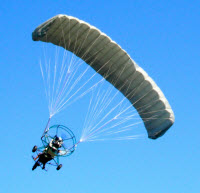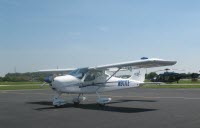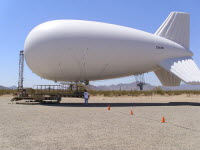Types of Lower Cost Aircraft
Staff at the National Law Enforcement and Corrections Technology Center are evaluating six types of lower cost aircraft. The six types are:
- Powered Parachutes
- Fixed-Wing Aircraft
- Weight-Shift Aircraft
- Gyroplanes
- Small Unmanned Aircraft
- Aerostats
NIJ is supported by logistical assistance from the Small, Rural, Tribal, and Border Regional Center of the National Law Enforcement and Corrections Technology Center, a component of the Center for Rural Development. The aircraft are spread out across the U.S. at participating law enforcement agencies.
Powered Parachutes

Powered parachute in flight
View larger version in NIJ's aviation image gallery.
NIJ photo (see reuse policy).
Powered parachutes were the first kinds of aviation assets that the program evaluated. The powered parachute is a tandem two-seat aircraft with a parachute as its wing. The cart attached to the parachute is an open cockpit with a metal roll cage. The aircraft has dual controls, allowing either occupant to take off and land the aircraft. Powered parachutes are easy for a trained user to control and can be deployed from almost any flat location. The powered parachute typically flies at a constant speed of 30 miles per hour (mph). The parachute is attached to the cart via a series of lines. The steering lines are attached to the outer edge of the parachute and routed through a series of pulleys to foot bars.
Advantages and Disadvantages of Powered Parachutes:
- A powered parachute costs $15,000 to $30,000 to purchase and $20 to $30 per hour to fuel and maintain.
- Powered parachutes do not require an airstrip for takeoff and landing.
- Powered parachutes have a fixed airspeed of 30 mph.
- Once in the air, the powered parachute offers outstanding visibility: a 270-degree unobstructed view allows the pilot and occupant to see far more in a powered parachute than any other aircraft.
- Powered parachutes are vulnerable to the elements and may not be able to fly in strong wind or bad weather.
Fixed-Wing Aircraft

Fixed-wing aircraft
View larger version in NIJ's aviation image gallery.
NIJ photo (see reuse policy).
Fixed-wing light sport aircraft are the traditional kind of planes encountered at small airports; the wings generate lift as the aircraft gains forward speed.
Advantages and Disadvantages of Fixed-Wing Aircraft
- Fixed-wing light sport aircraft generally cost between $60,000 and $130,000 to purchase and $50 per hour to fuel and maintain.
- They can fly at a wide range of speeds — 35 mph to 125 mph — making them an excellent platform for performing a broad range of law enforcement missions.
- The enclosed cockpit offers protection from the elements, permitting a longer flying season in cold regions.
- These sturdier planes can handle significantly stronger winds than the powered parachute.
- Fixed wings can carry a payload of up to 500 lbs.
- Fixed-wing aircraft are widely available across the United States, and finding training and maintenance support should be relatively easy.
- Fixed-wing aircraft have reduced visibility compared to other lower cost aircraft.
Weight-Shift Aircraft

Weight-shift aircraft
View larger version in NIJ's aviation image gallery.
Federal Aviation Administration photo (see reuse policy). From Weight-Shift Control Aircraft Flying Handbook (pdf)
The weight-shift aircraft is best described as a cross between a powered parachute and a fixed-wing aircraft. The cockpit is limited to two occupants. Weight-shift aircraft have a cart similar to the powered parachute but use a delta wing like a hang glider and often are called "trikes."
Advantages and Disadvantages of Weight-Shift Aircraft:
- Weight-shift aircraft cost $50,000 to $90,000 to acquire and approximately $18 per hour to fuel and another $20 per hour to maintain.
- The aircraft has a broad speed range (35 mph to 100 mph), allowing it to patrol slowly over an area or cover a large area.
- The weight-shift cockpit is open, providing exceptional visibility but also making it susceptible to bad weather.
- Weight-shift aircraft can handle wind better than a powered parachute but are still wind limited.
- Training opportunities and maintenance support are limited in many areas of the country because the aircraft are not widely used.
- The weight-shift aircraft's safety record is not as strong as that of the powered parachute.
Gyroplanes
The gyroplane resembles a helicopter, but with key differences. It uses an engine on the rear of the aircraft to create forward thrust. The rotor blades on top of the aircraft are engaged initially by the engine, but once the aircraft is in flight, the rotor blades continue to spin automatically as a result of airflow, not power from the engine. This is called autorotation.
The aircraft can fly at slow speeds and maintain tight orbits. The most challenging aspect of the use of a gyroplane is the lack of Federal Aviation Administration (FAA) airworthiness standards for manufactured aircraft and of available training support.
Advantages and Disadvantages of Gyroplanes:
- The cost of a gyroplane ranges between $60,000 and $100,000, and it has a low operating cost — approximately $40 per hour.
- Gyroplanes do not require an airstrip for takeoff and landing.
- Gyroplanes can fly low and at slow speeds and can maintain tight orbits. They cannot take off vertically, but can make very short takeoffs and landings.
- Gyroplanes have exceptional visibility, similar to the powered parachute.
- Gyroplanes present no risk of stalling, unlike a traditional fixed wing. If a gyroplane engine were to stop altogether in-air, it would begin to descend gradually. Despite being a three-axis aircraft, the gyroplane is remarkably stable.
- Training and maintenance for gyroplanes is currently limited.
- A gyroplane is capable of flying in strong winds and can land and take off safely in a strong crosswind.
Small Unmanned Aircraft
A sUAS typically refers to an unmanned aircraft weighing less than 25 pounds that can be flown by preprogrammed flight plans or manual controllers. A sUAS is typically equipped with a camera that wirelessly downlinks to a control station. A sUAS can be especially useful to law enforcement in time-sensitive missions that require a constant aerial view, such as a hostage situation.
The sensors on the aircraft can identify individuals by location, clothing, and even some biological features like skin and hair color. However, the attached cameras cannot currently identify faces, weapons, license plates or other fine detail.
FAA considers the sUAS an aircraft; currently, it cannot be flown under the public aircraft exemption. FAA uses a Certificate of Authorization process to ensure that an agency operating a sUAS has adequate knowledge and that the intended airspace of operation is safe for a sUAS.
Advantages and Disadvantages of Small Unmanned Aircraft Systems:
- The price of a sUAS ranges between $40,000 and $125,000; day-to-day operating costs are low because a sUAS operates on a rechargeable battery and requires no fuel. The wide price range is because of the varying levels of options and sophistication available.
- A sUAS is portable and can provide immediate and covert situational awareness of a crime scene (e.g., a hostage scene).
- The device can be both launched and recovered onsite by law enforcement personnel.
- Obtaining the FAA Certificate of Authorization to fly legally can be burdensome.
- Radio interference can cause control issues with the aircraft and GPS.
- Many of the commercially available aircraft are not designed for continuous operations and are fragile; consequently, this technology may not offer a good return on investment for all types of law enforcement agencies.
- Although camera technology is continually improving, cameras on a sUAS cannot currently provide fine detail, such as faces or weapons.
- The device cannot be flown legally in congested airspace and can only be airborne for a short time (typically 40 minutes or less).
Aerostats
An aerostat resembles a weather balloon and has the unique ability to rapidly deploy a camera or radio communication equipment. It can carry payloads ranging up to 12 pounds, allowing for a camera or radio transmitter to be deployed up to several hundred feet in the air. Aerostats can carry their payloads aloft for long periods of time, typically up to 72 hours, before requiring further helium.
NIJ's aviation technology program originally began evaluating aerostats to help create an improvised radio structure in remote locations or locations devastated by natural disasters. An aerostat could be launched with the repeater's creating a radio tower to expand the radio service area.
Advantages and Disadvantages of Aerostats:
- The price of an aerostat ranges from $5,000 to $500,000, depending on the balloon's specifications. Operating costs are low because the aerostat requires only helium to fly.
- The launch and recovery equipment can be extensive, requiring a trailer with multiple helium tanks to fill the balloon.
- Launch and recovery can be performed onsite.
- Unlike a sUAS, an aerostat can provide persistent surveillance or situational awareness from hours to days on station. Because it does not require fuel or electricity to stay in the air, it can be deployed for extended periods of time.
- FAA imposes fewer regulatory requirements on the use of aerostats.
- Aerostats do not have the same operational hurdles as a sUAS because they are anchored to the ground.
- The aerostat is fixed in location and cannot be used for covert operations.




